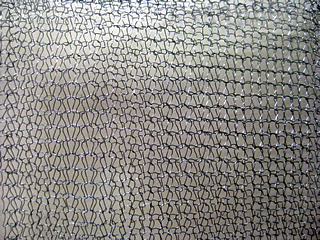Filters and their parts
Filter media (various metallic materials for filters)
Plain/twill-woven wire mesh
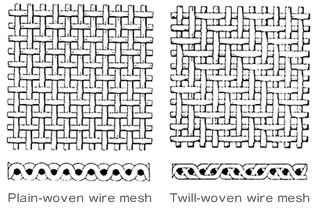 Plain/twill-woven wire mesh (square mesh) has been widely used to form filters and sieves. Weaving method is selected to meet such factors as the open area-to-wire size ratio and the application.
Plain/twill-woven wire mesh (square mesh) has been widely used to form filters and sieves. Weaving method is selected to meet such factors as the open area-to-wire size ratio and the application.
We have acquired high reputation particularly for our expertise in manufacturing fine mesh with aperture of 150μ and smaller.
Plain/twill-woven wire mesh specifications ※Detailed specifications can be found here.
- Mesh size
- 2 to 5 (Aperture size about 4.13mm to 11.2mm)
6 to 10 (Aperture size about 1.44mm to 3.58mm)
12 to 16 (Aperture size about 0.94mm to 1.74mm)
18 to 30 (Aperture size about 0.5mm to 1.21mm)
32 to 150 (Aperture size about 0.099mm to 0.57mm)
165 to T635 (Aperture size about 0.025mm to 0.109mm)
Dutch-woven wire mesh
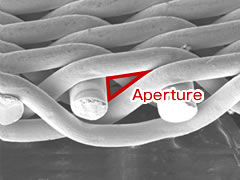 The main difference between an ordinary wire mesh (mesh with square apertures) and a wire mesh used as a filter is that the weft wires of the filter mesh are arranged in contact with each other so that no aperture can be seen from above (the so-called zero-open weave). Thus, the percentage of open area in the filter mesh cannot be measured precisely. Aperture size of the filter mesh can be estimated from the relationship between the flow rate of liquid and the pressure drop across it, or from the fine particle capturing capability.
The main difference between an ordinary wire mesh (mesh with square apertures) and a wire mesh used as a filter is that the weft wires of the filter mesh are arranged in contact with each other so that no aperture can be seen from above (the so-called zero-open weave). Thus, the percentage of open area in the filter mesh cannot be measured precisely. Aperture size of the filter mesh can be estimated from the relationship between the flow rate of liquid and the pressure drop across it, or from the fine particle capturing capability.
Aperture size of the filter wire mesh is determined by measuring the absolute value captured particle size (usually in micrometers) with the maximum bubble pressure method (JIS B8356).
Dutch-woven wire mesh specifications※Detailed specifications can be found here.
| Texture (Weaving) |
Material | Warp dia/ weft dia (mm) |
Longitudinal mesh/ transverse mesh (mesh) |
Weave width (mm) |
Absolute filtering size (µ) |
Nominal filtering size (µ) |
|---|---|---|---|---|---|---|
| Plain Dutch weave | Brass | 0.18/0.14 | 24/200 | 1000 | 150 | 100 |
| Plain Dutch weave | 304 | 0.21/0.14 | 24/200 | 1000 | 150 | 100 |
| Plain Dutch weave | 316/316L | 0.14/0.11 | 50/250 | 1000 | 75 | 60 |
| Twill Dutch weave | 316 | 0.1/0.09 | 80/600 | 1000 | 55 | 50 |
| Twill Dutch weave | 316 | 0.1/0.076 | 80/700 | 1000 | 50 | 45 |
| Twill Dutch weave | 316 | 0.1/0.07 | 80/800 | 1000 | 45 | 40 |
| Twill Dutch weave | 316/316L | 0.1/0.07 | 100/800 | 1000 | 35 | 30 |
| Twill Dutch weave | 316/316L | 0.08/0.053 | 120/1000 | 1000 | 30 | 27 |
| Twill Dutch weave | 316/316L | 0.07/0.05 | 165/800 | 1000 | 33 | 25 |
| Twill Dutch weave | 316/316L | 0.07/0.045 | 165/1200 | 1000 | 25 | 22 |
| Twill Dutch weave | 316/316L | 0.07/0.04 | 165/1400 | 1000 | 25 | 20 |
| Twill Dutch weave | 316/316L | 0.07/0.04 | 200/1400 | 1000/1220 | 20 | 15 |
| Twill Dutch weave | 316/316L | 0.055/0.037 | 250/1600 | 1000 | 15 | 12 |
| Twill Dutch weave | 316/316L | 0.05/0.028 | 200/2000 | 1000 | 19 | 12 |
| Twill Dutch weave | 316/316L | 0.04/0.028 | 270/2000 | 1000 | 12 | 10 |
| Twill Dutch weave | 316/316L | 0.035/0.025 | 325/2400 | 1000 | 10 | 8 |
| Twill Dutch weave | 316/316L | 0.03/0.022 | 350/2600 | 1000 | 10 | 7 |
| Twill Dutch weave | 316/316L | 0.03/0.018 | 400/3000 | 1000 | 9 | 6 |
| Twill Dutch weave | 316/316L | 0.025/0.015 | 500/3600 | 1000 | 7 | 5 |
Filtering size is estimated by measuring the bubble point value and the size of the contaminant particle passing through the wire mesh.
[Nominal filtering size: At least 95% of foreign matter larger than this value is removed.
Absolute filtering size: 100% of foreign matter larger than this value is removed.]
Sintered wire mesh
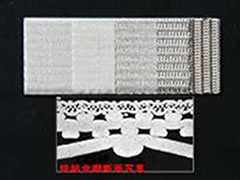 Several sheets of stainless steel wire mesh are placed one on another and are sintered under pressure, thus forming a filter with higher strength and higher sintering accuracy. We will produce an optimum filter medium by adjusting the composition (combination) of the wire mesh to meet the application.
Several sheets of stainless steel wire mesh are placed one on another and are sintered under pressure, thus forming a filter with higher strength and higher sintering accuracy. We will produce an optimum filter medium by adjusting the composition (combination) of the wire mesh to meet the application.
Filter medium for polymers will be provided with a high-strength support layer.
We can also manufacture pleated filter medium having an increased filtering area, and filter media integrated with reinforcing support layer for extrusion machines, so as to provide the best filter medium and elements for the application and the intended process.
Standard specifications of sintered wire mesh
| Standard filtering size | 2 | 5 | 10 | 20 | 40 | 75 | 100 | 150 | 200 | 300 |
|---|---|---|---|---|---|---|---|---|---|---|
| Thickness(mm) | 0.7 | 0.8 | 0.8 | 0.7 | 0.7 | 0.7 | 0.7 | 0.85 | 1.2 | 1.3 |
Construction of Poremet

Standard composition of filter medium
| Model Number | Standard wire mesh construction (mesh #) |
|---|---|
| PM0.3 | 100+500/3500+100+12/64+64/12 |
| PM0.5 | 100+400/3000+100+12/64+64/12 |
| PM2 | 100+325/2400+100+12/64+64/12 |
| PM3 | 100+250/1600+100+12/64+64/12 |
| PM5 | 100+200/1400+100+12/64+64/12 |
| PM10 | 100+165/1400+100+12/64+64/12 |
| PM15 | 100+165/1200+100+12/64+64/12 |
| PM20 | 100+165/800+100+12/64+64/12 |
| PM40 | 100+50/250+100+12/64+64/12 |
| PM75 | 100+200+100+12/64+64/12 |
| PM100 | 100+150+100+12/64+64/12 |
| PM150 | 50+100+40+20+40+100+50 |
| PM200 | 50+80+40+30+40+80+50 |
Specifications
| Material | In addition to SUS316L used as the standard material, other materials can also be used such as Hastelloy, Inconel, Monel SUS904L and nickel. |
|---|---|
| Process | Machining, welding, electrolytic polishing, buffing, etc. can be applied. |
| Dimensions | 1.Standard panel sizes as sintered are 500 by 1000mm, 1000 by 1000mm and 1200 by 1200mm. Cartridge filters of diverse shapes are made from these standard panels. 2.Standard thickness 1.7t |
| Cleaning | Can be cleaned repeatedly over a long period of time by high-pressure jet washing, ultrasonic cleaning hydrolysis or combustion cleaning. |
| Special order | Besides the standard 5-layer construction, panels of special construction can be produced upon order. |
Metal Fiber (Sintered nonwoven metal fabric)
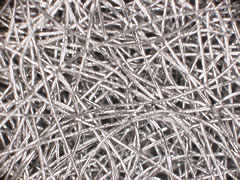 Sintered nonwoven fabric made of metal fibers measuring on the order of micrometers. In contrast to the stacked sintered wire mesh that performs filtering only on the surface layer, this fabric performs filtering both in the internal structure and on the surface layer. With the internal filtering structure having an extremely high void ratio, it has excellent foreign matter capturing effect. This is the long-awaited filter medium, capable of achieving high-speed filtering with low power consumption.
Sintered nonwoven fabric made of metal fibers measuring on the order of micrometers. In contrast to the stacked sintered wire mesh that performs filtering only on the surface layer, this fabric performs filtering both in the internal structure and on the surface layer. With the internal filtering structure having an extremely high void ratio, it has excellent foreign matter capturing effect. This is the long-awaited filter medium, capable of achieving high-speed filtering with low power consumption.
Fine pore NF standard specifications
Please contact us for information on “NF01M (Model name) 1µ (filtering accuracy)”, “Filtering flow rate of NF01M and NF02” and “Basic data”.
| Model | Filtering accuracy(㎛) | Filtering flow rate | ||
|---|---|---|---|---|
| Air (ℓ/cm2min) |
Water (cc/cm2min) |
High viscosity (cc/cm2min) |
||
| NF-02 | 2 | - | - | - |
| NF-03 | 3 | 0.15 | 20 | 0.15 |
| NF-05 | 5 | 0.31 | 40 | 0.3 |
| NF-06 | 10 | 1.1 | 140 | 1.2 |
| NF-07 | 15 | 1.8 | 200 | 1.7 |
| NF-08 | 20 | 2.4 | 300 | 2.3 |
| NF-09 | 25 | 3.2 | 400 | 3 |
| NF-10 | 30 | 5 | 600 | 4.5 |
| NF-12 | 40 | 6.4 | 750 | 6 |
| NF-13 | 60 | 9.2 | 1000 | 8.7 |
| NF-14 | 80 | 15 | 1500 | 12 |
| NF-15 | 100 | - | - | - |
Punching metal
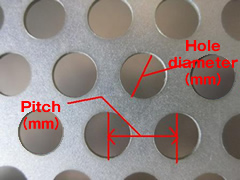 Steel sheet punched out with a press die to form a multitude of holes; it is also called punchout metal mesh.
Steel sheet punched out with a press die to form a multitude of holes; it is also called punchout metal mesh.
Standard specifications are: hole diameter 0.35 to 50mm; pitch 1 to 45mm; percentage of open area 10 to 60%. The hole shape may be round, cross, square, oval, etc. The holes are arranged in 60°staggered or parallel arrays.
Punching metal is used as a cover that passes air or sound, in sound insulation/heat insulation panel, interior/exterior material of buildings, strainers, granulation/crushing machine, sifting of grains, gravel or pharmaceutical materials, etc.
Punching metal cannot be used in filtration of fine particles due to limitations on the size of holes that can be formed, but it is used to reinforce the main filter.
Specifications of punching metal (SUS304)
| Sheet thickness | D×P (60°staggered) | Percentage of open area |
|---|---|---|
| 0.5t | 2×3 | 40.30% |
| 3×5 | 32.60% | |
| 5×8 | 35.40% | |
| 0.8t | 2×3 | 40.30% |
| 3×4 | 51% | |
| 3×5 | 32.60% | |
| 4×7 | 29.60% | |
| 5×8 | 35.40% | |
| 6×9 | 40.30% | |
| 8×10 | 58% | |
| 1t | 2×3 | 40.30% |
| 3×4 | 51% | |
| 3×5 | 32.60% | |
| 4×7 | 29.60% | |
| 5×8 | 35.40% | |
| 6×9 | 40.30% | |
| 8×10 | 58% | |
| 8×12 | 40.30% | |
| 10×12.5 | 58% | |
| 10×15 | 40.30% | |
| 1.5t | 3×4 | 51% |
| 3×5 | 32.60% | |
| 4×7 | 29.60% | |
| 5×8 | 35.40% | |
| 6×9 | 40.30% | |
| 8×10 | 58% | |
| 8×12 | 40.30% | |
| 10×12.5 | 58% | |
| 10×15 | 40.30% | |
| 2t | 3×5 | 32.60% |
| 4×7 | 29.60% | |
| 5×8 | 35.40% | |
| 6×9 | 40.30% | |
| 8×10 | 58% | |
| 8×12 | 40.30% | |
| 10×12.5 | 58% | |
| 10×15 | 40.30% |
Wire mesh demister
The wire mesh demister is used as a filler that is woven to separate (by fractionation, rectification) foreign matter from liquid or gas; it is also used as a shielding material or core material.
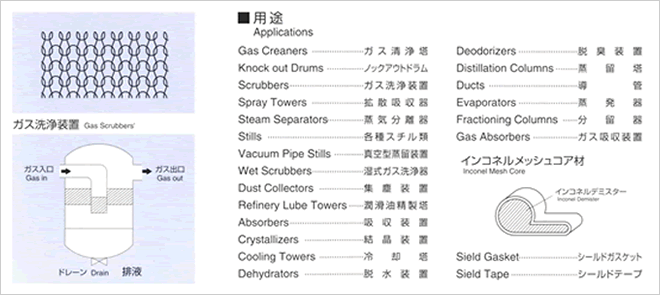
- Pressed demister stack 01
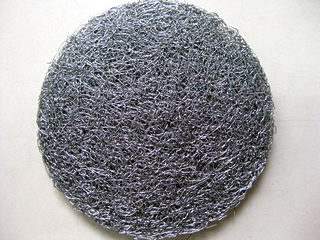
- Pressed demister stack 02
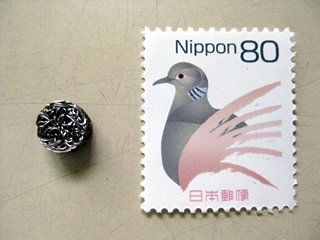
- Pleated demister stack
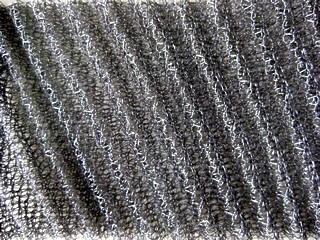
- Microscope photograph of demister
